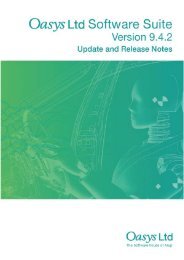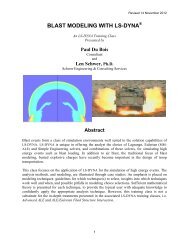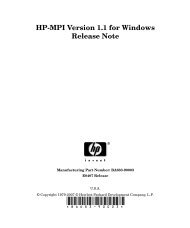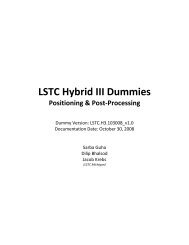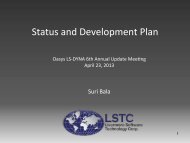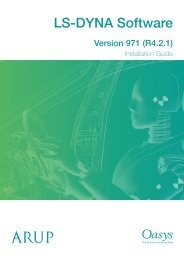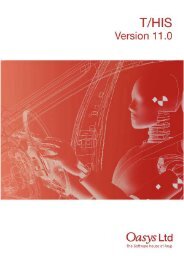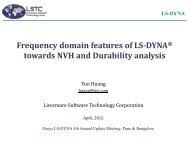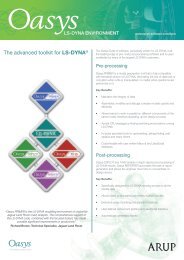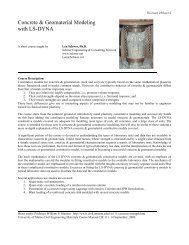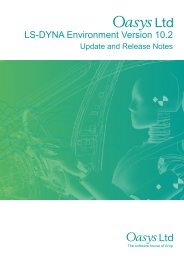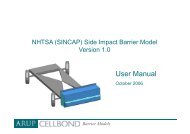Oasys LS-DYNA Environment 8.1 VOLUME 3 ... - Oasys Software
Oasys LS-DYNA Environment 8.1 VOLUME 3 ... - Oasys Software
Oasys LS-DYNA Environment 8.1 VOLUME 3 ... - Oasys Software
Create successful ePaper yourself
Turn your PDF publications into a flip-book with our unique Google optimized e-Paper software.
<strong>Oasys</strong> <strong>LS</strong>-<strong>DYNA</strong> <strong>Environment</strong>: User Guide (Version <strong>8.1</strong>)<br />
For spring elements the calculation is:<br />
t = 2(mk)<br />
Where m = m 1m 2/(m 1 + m 2)<br />
m 1,m 2 = mass of nodes<br />
k = current spring stiffness<br />
For dampers it is<br />
ìt = 0.1m/λ<br />
Where λ = damping constant<br />
m = as above<br />
For more details see Section 19 of the Theory Manual.<br />
On commencing the solution phase and also on restart <strong>LS</strong>-<strong>DYNA</strong> reports the 100 elements with<br />
the smallest timesteps to the .OTF file. There is also an option (IPNINT on<br />
*CONTROL_OUTPUT) to output the initial timestep of all the elements in the model.<br />
In most problems the stable timestep selected by <strong>LS</strong>-<strong>DYNA</strong> is small enough not to affect<br />
accuracy (i.e. use of a smaller timestep would produce the same answers).<br />
Exceptions occur when the highest modes in the model (i.e. single element modes) have a<br />
significant effect on the results, e.g. mass-spring models and shock wave problems. In these<br />
cases it is usually beneficial to reduce the timestep.<br />
Three options are available for preventing the timestep falling below a given value (all of these<br />
are on *CONTROL_TIMESTEP):<br />
TSLIMT (applies only to shell elements of material types 3, 18, 19 and 24). This reduces<br />
the Young's Modulus of elements which would otherwise demand a timestep less<br />
than TSLIMT. The timestep for the whole model is then prevented from falling<br />
below TSLIMT. This can be dangerous: if the critical element is not a shell<br />
element of the material types given above, the model may go unstable and the run<br />
may then crash.<br />
DT2MS When set to a negative value, this tells <strong>LS</strong>-<strong>DYNA</strong> to add mass to any element<br />
which would otherwise demand a timestep less than SCFT*DT2MS. Because<br />
this option applies to all element classes (except spring elements) and material<br />
types, it should be used in preference to TSLIMT. Use with ENDMAS on<br />
*CONTROL_TERMINATION.<br />
Page 12.2



